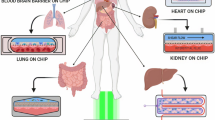Abstract
Aptamers are nucleic acid binding species capable of recognizing a wide variety of targets ranging from small organic molecules to supramolecular structures, including organisms. They are isolated from combinatorial libraries of synthetic nucleic acid by an iterative process referred to as SELEX (Systematic Evolution of Ligands by Exponential Enrichment). Here we describe an automated microfluidic, microline-based assembly that uses LabView-controlled actuatable valves and a PCR machine, and which is capable of the selection and synthesis of an anti-lysozyme aptamer as verified by sequence analysis. The microfluidic prototype described is 1) a simple apparatus that is relatively inexpensive to assemble, making automated aptamer selection accessible to many investigators, and 2) useful for the continued “morphing” of macro→meso→microfabricated structures until a convergence to a few functional systems evolves and emerges, partly or completely achieving simpler, smaller and more rapid SELEX applications.




Similar content being viewed by others
References
Jayasena SD (1999) Clin Chem 45:1628–1650
Rajendran M, Ellington AD (2002) Comb Chem High T Scr 5:263–270
Wilson DS, Szostak JW (1999) Annu Rev Biochem 68:611–647
Tuerk C, Gold L (1990) Science 1249:505–510
Ellington AD, Szostak JW (1990) Nature 346:818–822
Cox JC, Ellington AD (2001) Bioorgan Med Chem 9:2525–2531
Gold L, Zichi DA, Smith JD, Schneider DJ (2003) United States Patent Application Publication: US 2003/0054360 A1
Wang J (2002) Electrophoresis 23:713–718
Hadd AG, Raymond DE, Halliwell JW, Jacobson SC, Ramsey JM (1997) Anal Chem 69:3407–3412
Sato K, Tokeshi M, Kimura H, Kitamori T (2001) Anal Chem 73:1213–1218
Wang J, Ibanez A, Chatrathi MP, Escarpa A (2001) Anal Chem 73:5323–5327
Righetti PG, Gelfi C, Acunto MR (2002) Electrophoresis 23:1361–1374
Fan ZH, Mangru S, Granzow R, Heaney P, Ho W, Dong Q, Kumar R (1999) Anal Chem 71:4851–4859
Anderson RC, Su X, Bogdan GJ, Fenton J (2000) Nucleic Acids Res 28:e60
Liu RH, Yang J, Lenigk R, Bonanno J, Grodzinski P (2004) Anal Chem 76:1824–1831
Soper SA, Williams DC, Xu Y, Lassiter SJ, Zhang Y, Ford SM, Bruch RC (1998) Anal Chem 70:4038–4045
Hesselberth J, Robertson MP, Jhaveri S, Ellington AD (2000) Rev Mol Biotechnol 74:15–25
Brody EN, Gold L (2000) J Mol Biotechnol 74:5–13
Osbourne SE, Matsumura I, Ellington AD (1997) Curr Opin Chem Biol 1:5–9
McEnery M, Tan A, Alderman J, Patterson J, O’Mathuna SC, Glennon JD (2000) Analyst 125:25–27
Liu H, Felten C, Xue Q, Zhang B, Jedrzjewski P, Karger BL, Foret F (2000) Anal Chem 72:3303–3310
Roper MG, Easley CJ, Landers JP (2005) Anal Chem 77:3887–3894
Mao H, Holdin MA, You M, Cremer PS (2002) Anal Chem 74:5071–5075
Koh CG, Tan W, Zhao M, Ricco AJ, Fan ZH (2003) Anal Chem 75:4591–4598
Acknowledgements
The research reported in this document/presentation was supported in part by Contract number DAAD17-01-D-0001 (U.S. Army Research Laboratory) and NIH Grant 3S06GM008194-25S1. The views and conclusions contained in this document/presentation are those of the authors and should not be interpreted as presenting the official policies or position, either expressed or implied, of the U.S. Army Research Laboratory or the U.S. Government unless so designated by other authorized documents. Citation of manufacturer’s or trade names does not constitute an official endorsement or approval of the use thereof. The U.S. Government is authorized to reproduce and distribute reprints for Government purposes notwithstanding any copyright notation hereon.
Author information
Authors and Affiliations
Corresponding author
Rights and permissions
About this article
Cite this article
Hybarger, G., Bynum, J., Williams, R.F. et al. A microfluidic SELEX prototype. Anal Bioanal Chem 384, 191–198 (2006). https://doi.org/10.1007/s00216-005-0089-3
Received:
Revised:
Accepted:
Published:
Issue Date:
DOI: https://doi.org/10.1007/s00216-005-0089-3




